Jana al-Issa | Hassan Ibrahim | Lujain Mourad | Muhammed Fansa
Russia and Iran provided the Syrian regime with the reasons for its military, political and economic survival during a decade of the revolution. The two allies tipped the balance of powers in the battles for Bashar al-Assad’s favor after the opposition reached the outskirts of the capital, Damascus.
In parallel to the military process, Moscow has obstructed decisions to condemn the regime by using its “veto” 16 times, under its surrounding political isolation as a result of its adherence to power and its refusal to abide by resolutions of international legitimacy.
In the midst of the Russian war on Ukraine and the popular Iranian uprising, questions arise about the extent to which these changes affect the mechanism and continuity of the two allies’ support for the regime at the same pace.
Russia’s invasion of its neighbor Ukraine since 24 February bears features of a long, high-tax war. In addition, an expanding Iranian public outcry erupted more than 40 days ago against the backdrop of accusing the Iranian Morality Police of killing the young woman, Mahsa Amini, under torture for violating the authority-established “dress code,” which created a wave of protests calling for the overthrow of the Supreme Leader of the Iranian Islamic Revolution, Ali Khamenei, and the country’s existing regime since the overthrow of the Shah, Mohammad Reza Pahlavi, in 1979.
Their future is “more and more threatened”
Allied circles are “scattered”
Russia’s invasion of Ukraine has gone through many stages leading to Ukraine’s weeks-long counter-attack east of the country, which prompted Moscow to wave the use of nuclear weapons.
Ukraine’s position seemed more firm and coherent with time, particularly as European and US military support for Kyiv continued to flow. Last August, Ukrainian forces launched a broad counter-attack and regained control of dozens of villages, disrupting Russian supply lines.
Russian Defense Minister Sergei Shoigu stated at the end of September that the Russian army’s casualties amounted to 5937 people, while the US Department of Defense estimated that about 80,000 Russian soldiers were injured or killed in the conflict.
In an attempt to tip the balance of power, Russian forces have been using drones, which Ukrainian military authorities said were Iranian, in their attacks since mid-October. The United States and the European Union have also accused Iran of helping Russians target Ukraine with drones, while Tehran denies this.
Iran, popular movement that concerns the authority
Since mid-September, Iran has been witnessing continuous protests and confrontations with the Iranian security forces over the killing of the young Iranian woman, Mahsa Amini. As a result of the protests, 253 people were killed, including 34 child protesters, according to Iran Human Rights (IHR) on 28 October.
On 13 September last, Mahsa Amini was killed after being detained by Iranian Morality Police elements for what the Iranian authorities consider to be a “dress code violation,” with accusations of Morality Police elements killing her under torture.
Amnesty International has called for a “criminal investigation into the circumstances (suspicious death) of 22-year-old Amini, which include allegations of torture and other ill-treatment during detention”.
On 11 October, Ali Khamenei, the Leader of the Iranian Revolution, commented on the protests and attributed them to “external” factors after their expansion and the imposition of Western sanctions on people accused of “responsibility for repression.”
On the 27th of the same month, the Iranian President, Ibrahim Raisi, considered that the “riots” were preparing the ground for “terrorist attacks” in response to the Shiraz incident.
In a report published by the American newspaper The Atlantic early this year, researcher and non-resident fellow of the Carnegie Endowment for International Peace, Kim Ghattas, said she feared that the Syrian scenario would be repeated in Iran, citing what happened in Syria when the Syrian regime’s inability to deliver effective reforms motivated protests. With the use of violence against protesters, many of them took up arms, and groups were formed against the regime that adopted the “scorched earth” policy.
According to the researcher, the protests could help weaken Iran’s “grip on what it considers its forward defense bases” in Syria, Lebanon, and Iraq.
In Syria, “swinging” control map between the two allies
After previous speculations about Russia reducing the number of its military forces in Syria to strengthen its fighting front in Ukraine, the talk has become a reality, manifested by several moves that Moscow has made for its forces on Syrian territory, the most recent of which is Russia’s recent withdrawal of “sensitive” military forces and equipment from Syria to enhance its military operations in Ukraine, according to a New York Times report quoting three senior officials residing in the Middle East on 19 October.
Two officials confirmed to the newspaper that the number of Russian troops withdrawn from Syria ranged from 1200 to 1600 military personnel. A third estimated that the number was much higher, indicating a general consensus on the reduction of the number of Russian fighting forces in Syria.
The newspaper noted that Russia’s “faltering” war in Ukraine had eroded Moscow’s influence elsewhere, particularly in Syria, which it has backed militarily since September 2015.
Moscow redeployed several Russian leaders from Syria to Ukraine, and Russia’s military leadership in Moscow became less involved in the day-to-day management of operations in Syria, an Israeli official told the newspaper.
The talk of reducing Russian forces and equipment in Syria is not new, but it returns with every emergency and change in the map of military control over the fighting fronts and battles in Ukraine, in addition to Moscow appointing military leaders who fought and led battles in Syria, the latest of which was Moscow’s appointment of General Sergei Surovikin (Commander of the Russian Air Force in Syria since 31 October 2017) as commander of the Russian forces in Ukraine on 8 October.
Last August, Russia shipped the advanced S-300 air defense system from Syria near the city of Masyaf, southwest of Hama, and relocated the system’s radar to the Hmeimim military base, southeast of Latakia. The S-300 system’s battery was transferred to the seaport of Tartus, from which it was loaded onto a Russian vessel bound for the Black Sea port of Novorossiysk.
The Moscow Times said last May that Russia had moved several military units from bases across Syria to three Mediterranean airports, estimated at more than 60,000 military personnel, half of whom were officers. These units were transferred to Ukraine, noting that the vacuum was filled by the Iranian Revolutionary Guard and the Lebanese Hezbollah, with information and numbers that were met with skepticism at the time.
Reduction of presence, no military vacuum
Russian analyst and non-resident scholar in the Syria program at the Middle East Institute, Anton Mardasov, considered it wrong to say that Russia is seriously reducing its presence in Syria o some minimal limits precisely because of the war in Ukraine, noting that Russia had taken some measures (troop reductions) but within the framework of objective optimization.
Mardasov told Enab Baladi that the Russian defense system currently in Syria (an air group the size of an air regiment, Iskander missile systems, and others) allows the Russian military to perform previous tasks, including organizing exercises and patrols together with Turkey and separately in eastern Syria. Moscow had previously announced its serious intention to reduce the number of its forces in 2021, that is, before the start of the invasion of Ukraine.
For his part, the head of the Information Unit at the Omran Center for Strategic Studies, researcher Nawar Shaaban, believes that the military vacuum of Syria’s allies, Iran and Russia, exists, but the security and administrative vacuum does not exist because Russia and Iran have moved to the second stage in Syria, which is the stage of administration with soft instruments. Russia is more adept at utilizing these instruments than Iran, while the latter is always trying to use soft non-circulating instruments to protect its militias by integrating them with the said instruments.
Speaking to Enab Baladi, Shaaban said that the Russian and Iranian military system operating in Syria had diminished its work since 2018, and its activity has become limited with regard to establishing a military reality that is currently proven; Russia and Iran worked on the principle of strengthening military forces to create a security reality in Syria previously, and they succeeded in that.
Russia continues to conduct periodic and frequent patrols in several villages in the eastern countryside of Deir Ezzor and on the international highway M4 in the regions of eastern Syria. It also recently conducted surveillance patrols on the border line with Jordan from the Nassib border crossing, south of Daraa, to the Syrian regime’s Border Guard outpost No. 107 near the town of Khazma, southeast of As-Suwayda.
The Russian analyst pointed out that the talks of the Russian and Turkish presidents, Vladimir Putin and Recep Tayyip Erdogan, are also related to the fact that for Moscow, any Turkish operation would entail the need to move additional forces into Syria, primarily military police, which the Kremlin needs to control the recently annexed territories of Ukraine.
The Moscow “cease-fire” agreement, signed between the Russian President and his Turkish counterpart, is the cornerstone to any military action in northwestern Syria. This agreement halted the map of military changes and the controlling forces since it was signed on 5 March 2020, although it was subjected to numerous violations, most notably the almost daily Russian bombing of opposition-held areas.
Despite the withdrawal of the S-300 air defense system, Mardasov indicated that the S-400 system, in addition to other air defense assets, remained in the Masyaf region. Russia does not use it against Israel for several reasons, most notably its unwillingness to get involved in a regional confrontation.
For her part, Pr. Dara Conduit, a political science lecturer and non-resident scholar in the Syria program at the Middle East Institute, does not believe that Russia will withdraw from Syria, as its military campaign in Ukraine uses a completely different part of its army than its project in Syria, which mainly depends on its air force.
Researcher Conduit told Enab Baladi that Russia has very clear interests in Syria, such as the Tartus sea port and the Hmeimim air base, which gives it strategic depth, including access to the Mediterranean Sea. Russia is also hoping for a return on its military investments through lucrative reconstruction projects that are still at the beginning, suggesting that Russia will not abandon these gains in the short term.
Iran is taking advantage of the Russian situation
With any talk of Moscow withdrawing or reducing its forces in Syria, attention turns to Iran, the other ally of the regime, coinciding with information, analysis, and speculations about Iran benefiting from the military situation in Russia and its preoccupation with Ukraine through Tehran strengthening many of its positions in Syria.
The Iranian Revolutionary Guard (IRG) has strengthened its military presence in Mahin warehouses in the Palmyra desert, the second largest arms and ammunition depot in Syria, after a complete withdrawal of the Russian forces and the Fifth Corps affiliated with it towards the Palmyra military airport, the Asharq Al-Awsat reported last April.
The Russian withdrawal from “Mahin” opened the door to a long geographical Iranian influence extending from the Qalamoun regions bordering Lebanon to the towns of Deir Atiyah, Mahin, al-Qaryatayn, and al-Sukhnah, east of Homs, reaching the areas of Athriya in the eastern countryside of Hama, and the oil fields in the south of al-Tabqa in the countryside of Raqqa governorate.
Diaa Kaddour, a researcher covering Iranian affairs, told Enab Baladi that the vacuum that will happen by the Russians reducing their influence in Syria is greater than the Iranians’ ability to fill, especially since the strengthening of Iran’s strategic depth in Syria comes with high economic costs and fewer benefits for the Iranians who are besieged by Western sanctions.
Kaddour believes that the Iranians will seek to exploit this situation (reducing Russian forces in Syria) by only controlling important vital sectors in the various military, political and economic fields.
Iran is seeking as much as possible to establish control points and control the situation in light of the increasing weakness of the Russians and the regime against the backdrop of the Ukrainian war and the international unwillingness to move the stagnant Syrian waters, the researcher adds.
Last May, the President of the Syrian regime, Bashar al-Assad, met his Iranian counterpart, Ibrahim Raisi, and Supreme Leader Ayatollah Ali Khamenei on an official visit to Tehran, the second time that al-Assad visited Tehran since the outbreak of the Syrian revolution in 2011.
The visit brought with it a talk about the messages, connotations, and their purpose, amid the involvement of the regime’s Russian ally in its war against Ukraine.
It was preceded by the visit of the former head of the regime’s intelligence services and director of the National Security Office, Major General Ali Mamlouk, to meet with senior Iranian officials last February and the visit of Iranian Foreign Minister Hossein Amir Abdollahian to Syria last March.
In a report published by the Al-Sharq Center for Strategic Research last June, it was considered that Iranian leaders had already sought to benefit from Assad’s concerns about the changing Russian role and increase their political space in Syria.
The think tank said Assad’s visit to Tehran is an initiative by Tehran to reassure Bashar al-Assad that he can still count on Iran’s full support, regardless of Russia’s role.
The report prepared by Hamid Reza Azizi, a researcher at the German Institute for International and Security Affairs, said that Iran is also trying to take advantage of the conditions in the economic field, as Iranian leaders hope that Russia’s economic problems as a result of Western sanctions on the one hand and the possibility of Iranian sanctions being lifted with the possibility of reviving the nuclear agreement of 2015 (JCPOA) on the other hand, may give Tehran greater room for maneuver in the economic reconstruction of post-war Syria as it has been increasingly marginalized by the Russians over the past four years.
‘No current repercussions’
Talks about Iran exploiting Russia’s preoccupation with Ukraine by seizing control of more sites and expanding its influence at Russia’s expense in Syria decreased with Tehran’s involvement in the Russian invasion of Ukraine by providing Russia with missiles and drones and the wave of protests taking place in Iranian cities.
Researcher Dara Conduit says that protests at home represent a big problem for Iran, especially the Revolutionary Guard, which was literally formed to protect the Iranian regime, and although the Iranian regime and the Revolutionary Guard will use all available resources to suppress that movement and protests, it is also important not to underestimate from the depth of the interests of the IRG in Syria.
|
Syria is central to the Islamic Revolutionary Guard Corps (IRGC) ’s world view, its regional goals, and its actual presence. Iran has spent huge political, financial, and military capital in Syria to achieve its goals, and I do not think it will give up easily. The matter is facilitated by the fact that Iran has foreign militias at its disposal in Syria, and even if the Revolutionary Guard’s attention is temporarily diverted from Syria, its military presence and influence will remain, and I do not expect a significant change in the Iranian presence in Syria at this stage. Lecturer in political science and non-resident researcher in the Syria program at the Middle East Institute, Dr. Dara Conduit |
The expert on Iranian affairs, Diaa Kaddour, does not believe that there are any repercussions of the Iranian uprising on Iranian influence in Syria in the short term, with the possibility of influence in the long term, but this, in his opinion, depends on the extent of the continuity of the popular uprising in the face of the iron fist of the ruling Iranian regime.
Kaddour expected that the Russians’ drowning more and more in the long Ukrainian war would lead to the Iranians drowning with them and depleting their strategic stocks of drones and precision missiles.
This will, of course, affect Iran’s maneuvering capabilities in the region to arm regional agents and continue its policy of exporting “violence and terrorism” to the region, according to the expert.
|
Russia’s dragging Iran into the Ukrainian war will have heavy costs on Iranian foreign policy in several international files, the most important of which is Iranian influence in Syria and the nuclear file. Diaa Kaddour, a writer and researcher on Iranian affairs |
For his part, the Russian analyst and non-resident researcher in the Syria program at the Middle East Institute, Anton Mardasov, said that Moscow has little desire to continue competing with Iran for influence in Syria, in conjunction with the war in Ukraine and the aggravated sense of partnership in the anti-American coalition.
He pointed out that the Russian army left different sites dozens of times before the Russian war in Ukraine, which were then occupied by various loyalist groups.
Fifth Corps units have also been deployed all over Syria, and Moscow has “illusions” that they are agents of Russian interests, but this is an illusion, according to Mardasov, because these units have a questionable legal status from the point of view of the Assad regime.
The researcher, Nawar Shaaban, considered that the withdrawal of military forces from Russia and Iran would not affect Syria because there is no rival, and there is no one in the region, whether local or international, who dares to fill this void, and it is likely that the reality will continue as it is now.
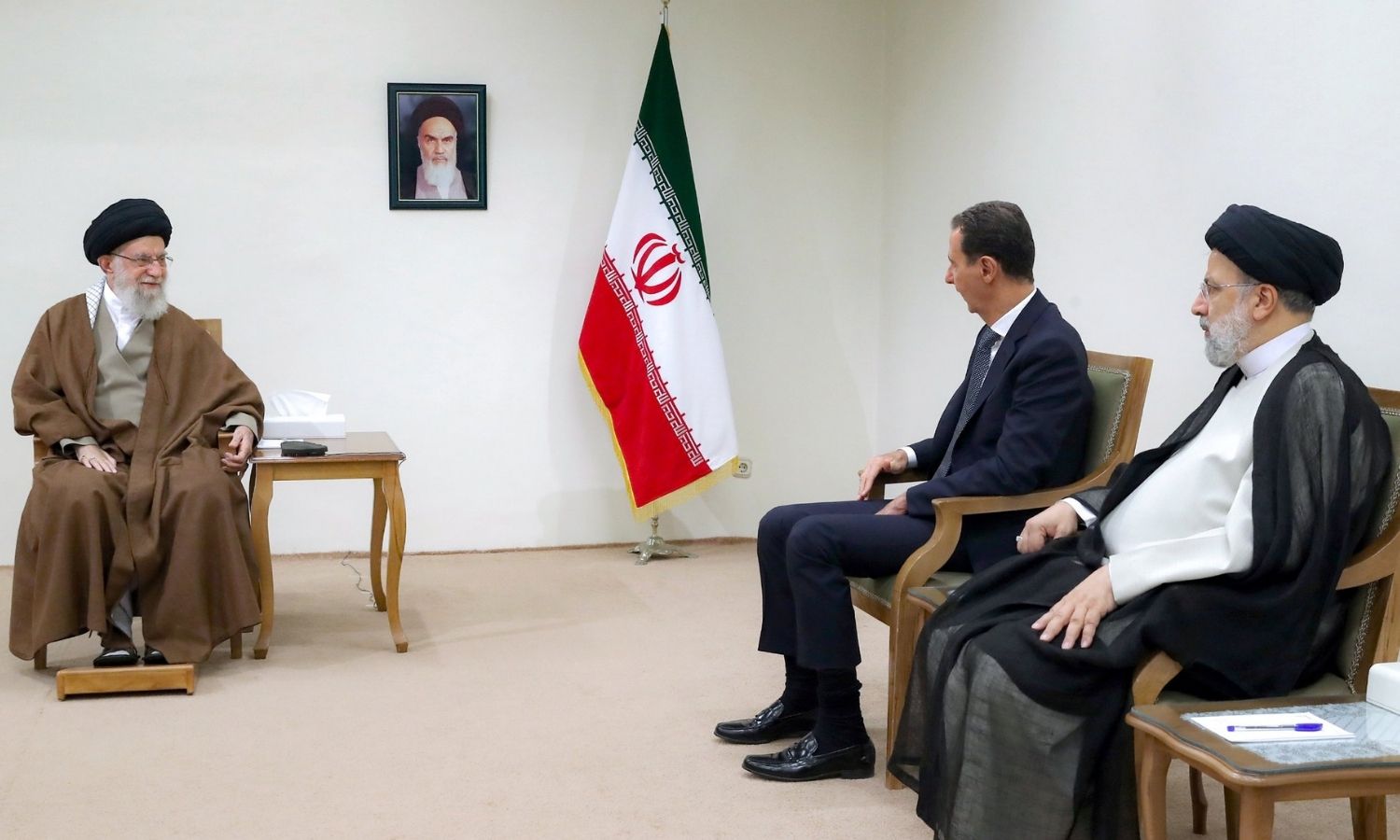
President of the Syrian regime, Bashar al-Assad, Supreme Leader of the Iranian Revolution, Ayatollah Ali Khamenei, and Iranian President, Ibrahim Raisi, 8 May 2022 (Khamenei’s Twitter account)
Is Assad weak while the allies are busy?
Both Russia and Iran played pivotal roles in preventing the collapse of the Syrian regime and provided it with continuous support during the previous years, but the two countries’ preoccupation and the hypothesis of the impact of this on the size of their presence in Syria created questions about the extent to which Assad’s strength is linked to their presence and the files that he may lose as a result.
Russian analyst Anton Mardasov considers that Assad understands that he cannot do without Russian support. That is why he recently recognized the “independence and sovereignty” of both the “Luhansk People’s Republic” and the “Donetsk People’s Republic,” which were controlled by Russia with the support of separatist forces in Ukraine.
Mardasov believes that the Syrian regime found in the Russian invasion of Ukraine an opportunity for it to negotiate behind the scenes and expand maneuvering space behind Moscow’s back.
He added that it is clear that Damascus is trying to get certain preferences from its defenders and, at the same time, finding opportunities for diversification that neither Iran nor Russia can sabotage, such as stepping up contacts with the UAE and other regional players.
In recent months, the pace of combat exercises conducted by the Syrian regime forces under Russian supervision increased, in which parachute landings took the lead.
Last week, the Syrian Ministry of Defense announced that the regime’s ground and air forces had implemented a tactical, operational project with live ammunition over a period of several days in cooperation with “friendly Russian forces operating in Syria.”
Mardasov considered that these exercises under Russian supervision are taking place regularly, in accordance with the combat training schedule of the Russian army.
He explained that Russia’s focus on training the Tiger Forces (25th Special Forces Division) is due to the participation of its units in military operations in the Syrian desert, in addition to these exercises allowing Moscow to maintain the level of military cooperation at a difficult time for it.
For his part, writer and researcher on Iranian affairs, Diaa Kaddour, believes that Iran’s preoccupation is weakening Assad, as the decline in its military influence may severely weaken his current position.
This decline at various levels, including the economic one, could also have “devastating” effects on the regime that lives today on the Iranian economic “ventilator,” as he described it.
Kaddour considers that the talk that Assad is today at his weakest due to the preoccupation of his two main allies is theoretically correct, but there is nothing to support this talk at the present time on the ground, as both allies do not show any signs of the military, political or economic retreat on the Syrian soil, adding, “Perhaps we should wait to see the long-term results of the Ukrainian war.”
“Advance strategy to leave a safe distance”
Prior to all these events, an analysis report published on the Newlines Institute website in March 2021 said that Bashar al-Assad pursued a strategy aimed at leaving a certain safe distance between himself and Iran and Russia, which have become controlling large sectors in Syria.
The report clarified that “al-Assad began to make quiet and pivotal changes in the security services and postponed others” to re-establish his control over them, and it is one of the security branches in which Russia and Iran are deeply interfering, and what was considered that Assad is thus strengthening his trusted inner circle.
The report considered that the aim of these changes is to ensure that there is no coup against al-Assad and to protect himself by ensuring the loyalty of the heads of the main security offices, intelligence branches, and senior officers of the presidential palace, or to ensure that corruption does not spread in these agencies and branches, which makes al-Assad vulnerable to further Iranian and Russian infiltration by bribing officers and senior officials.
“Opportunity” for the Syrian opposition
Claims have emerged that did not go beyond social media pages, stating that the Syrian opposition has an “opportunity” to change the reality that has been going on in Syria for years, in light of speculation about the position of the Syrian regime at the present time, with the preoccupation of its two allies.
Although military action is “not currently possible” in light of the Moscow “cease-fire” agreement signed in 2020 between Russian President Vladimir Putin and his Turkish counterpart, Recep Tayyip Erdogan, there is still a political “opportunity.”
The reason lies in the fact that Russia and Iran, the “busy” ones, control the active negotiation tracks to reach a political solution in Syria. Russia and Iran, in addition to Turkey, control the Astana track as the guarantor countries, which gives them the opportunity to control the track and manipulate its course.
The Iranian and Russian role in manipulating and disrupting the Syrian political file is evident in turning the Astana talks on Syria into repeated rounds that do not make any progress.
This was confirmed by the final statement of the 18th round of talks in the Kazakh capital, Nur-Sultan, on 16 June, which did not differ in content from the previous rounds, and was limited to emphasizing the previous items.
Russia also continues to obstruct the work of the Syrian Constitutional Committee (SCC) emanating from the Astana rounds by refusing to hold the committee’s meetings in Geneva, against the background of the Swiss position in Ukraine, and its proposal for alternative cities, a position supported by the Syrian regime, and rejected by the UN and the opposition.
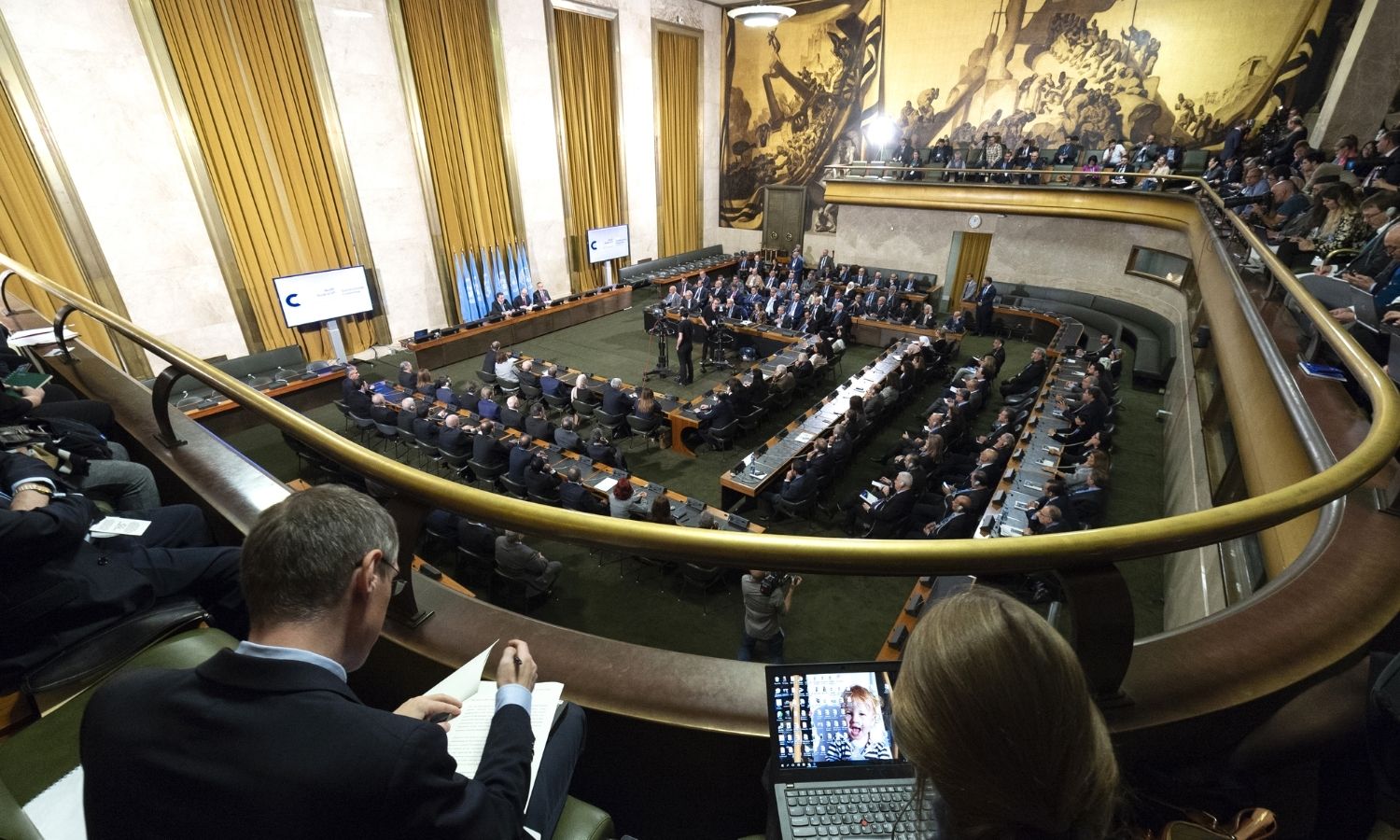
Meetings of the Syrian Constitutional Committee in Geneva – 30 October 2019 (UN Photo – Violaine Martin)
Opposition: Opportunity will not be repeated
In an interview with Enab Baladi, a member of the General Committee of the Syrian National Coalition (SNC), Nasr Hariri, said that benefiting from the current situation of the Syrian regime and its ally can be shared between the opposition and the countries that see Iran and Russia as a threat to them.
“The opposition’s role today can be in two directions, the first of which is subjective and starts from improving the building of “revolutionary” institutions, on top of which are the Coalition, the Syrian Interim Government (SIG), the Syrian National Army (SNA), security, the judiciary and the rest of the institutions, adding that the opposition’s primary role is linked to strengthening its legitimacy and trust between it and the “revolutionary incubator” and the identification of its strength factors, Hariri says.
As for the second trend, it is to develop the relationship and alliance with stakeholders in the solution in Syria, to limit the influence of Iran and Russia in the region and the world, considering that the alliance will be built on the basis of common interests with priority given to the “Syrian national interest,” according to Hariri.
“These developments exist and are discussed on the table by the opposition, but they require a clear action plan with a specific timetable to take advantage of the opportunity that most likely will not be repeated,” Hariri asserts.
Dr. Khaled Khoja, the former head of the Syrian National Coalition, said in an interview with Enab Baladi that the current situation of the Syrian regime provides opportunities for the opposition to move against the Syrian regime in a way that reflects “the will of the revolutionary street,” but these opportunities are dependent on several factors, which are not possible to achieve.
Among the most prominent factors mentioned by Khoja is the independence of the “revolutionary decision” and the harmony of the political movement with the military on the ground.
He also pointed out that the countries that control the “game” in Syria are still determining the paths of the regime and the opposition, which does not show the indicators of achieving these two factors.
|
Seizing the opportunity will not be at the hands of the opposition with its current components, as change requires reshaping the opposition to gain popular support and reverse the direction of pressure to become from the inside out. Khaled Khoja, The former head of the opposition’s Syrian National Coalition |
Khoja asserts that the only opportunity can start from the Syrian street, not from the existing opposition entities, as he believes that the popular movement that the various regions of northwestern Syria have witnessed recently reflects the weight of the “revolutionary” street.
Attempts to separate files
Hariri and Khoja agree that there are attempts to separate the internal files of Iran and Russia from the Syrian file, even though Russia and Iran are the two most prominent allies of the Syrian regime, and they appear in most of the files related to the Syrian reality.
One of the indications that the international community is continuing its attempts to isolate the Syrian file from the Ukrainian is the West’s resort to a policy of escalation and open and rapid support in Ukraine while resorting to a truce and calm with Russia regarding the Syrian file, according to Hariri.
The Syrian file is mainly linked to the inaction of the world and the international community to support the Syrians, which gave the Russian and Iranian intervention a greater impact on the Syrian file, Hariri considered.
The former head of the Coalition believes that the statement of the US administration at the beginning of the Russian invasion of Ukraine regarding the continuation of the disengagement agreement in Syria between the US and Russia negates the impact of the Ukrainian war on the Syrian military file from this aspect.
Khoja added that the opposition’s dependence on the Sochi track, which goes beyond the UN resolutions to minimize the political solution in Syria into a constitutional amendment and elections according to the vision of Russian President Vladimir Putin, is what imposed pressure on the opposition, both political and military, and not on the regime, and that the opposition was subject to the international will which kept it away from its revolutionary incubator.
if you think the article contain wrong information or you have additional details Send Correction
النسخة العربية من المقال
-
Follow us :
Most viewed
- Al-Sharaa names new Syrian government
- Intentions for popular resistance amid Israeli escalation in southern Syria
- Kurdish Protection Units: Key point of contention between Damascus and SDF
- Syrians look forward to visiting graves of "martyrs" on Eid morning
- Eid clothing prices rise in Idlib: Predominantly priced in dollars













 (Modified by Enab Baladi)
(Modified by Enab Baladi)





 A
A
A
A
A
A

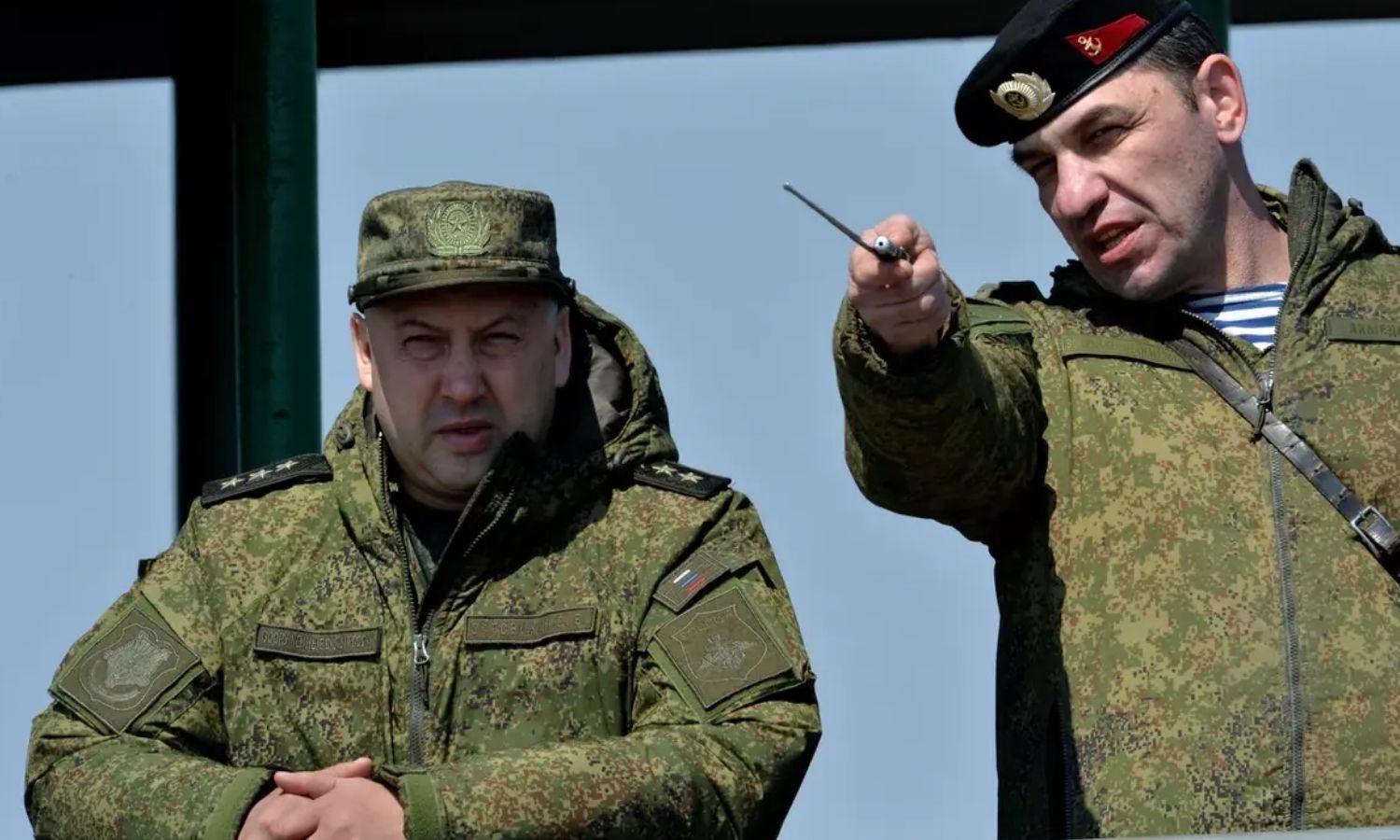





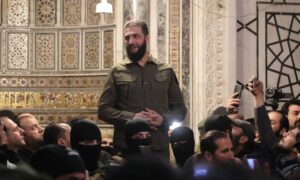
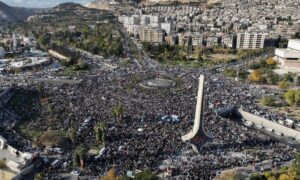
 More In-Depth
More In-Depth